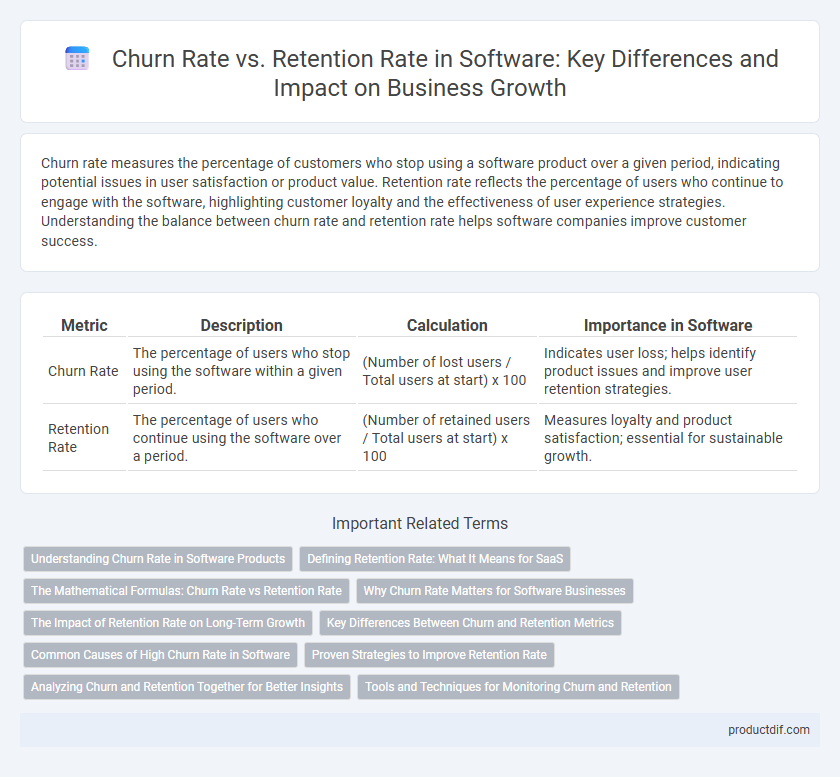Churn rate measures the percentage of customers who stop using a software product over a given period, indicating potential issues in user satisfaction or product value. Retention rate reflects the percentage of users who continue to engage with the software, highlighting customer loyalty and the effectiveness of user experience strategies. Understanding the balance between churn rate and retention rate helps software companies improve customer success.
Table of Comparison
| Metric | Description | Calculation | Importance in Software |
|---|---|---|---|
| Churn Rate | The percentage of users who stop using the software within a given period. | (Number of lost users / Total users at start) x 100 | Indicates user loss; helps identify product issues and improve user retention strategies. |
| Retention Rate | The percentage of users who continue using the software over a period. | (Number of retained users / Total users at start) x 100 | Measures loyalty and product satisfaction; essential for sustainable growth. |
Understanding Churn Rate in Software Products
Churn rate in software products measures the percentage of users who stop using the application within a specific period, directly impacting revenue and growth projections. Accurately tracking user churn helps identify product weaknesses, customer dissatisfaction, or competitive pressures driving attrition. Optimizing churn rate through proactive engagement and feature improvement enhances user retention, lifetime value, and product success.
Defining Retention Rate: What It Means for SaaS
Retention Rate in SaaS measures the percentage of users who continue subscribing over a specific period, reflecting customer loyalty and product value. A high retention rate directly correlates with sustainable revenue streams and lower customer acquisition costs. Improving this metric involves enhancing user experience, consistent product updates, and effective customer support tailored to reduce churn rate.
The Mathematical Formulas: Churn Rate vs Retention Rate
Churn Rate is calculated by dividing the number of customers lost during a period by the total customers at the start, expressed as Churn Rate = (Customers Lost / Customers at Start) x 100. Retention Rate measures the percentage of customers retained, given by Retention Rate = [(Customers at End - New Customers Acquired) / Customers at Start] x 100. Understanding these mathematical formulas helps software businesses analyze customer behavior and optimize growth strategies through precise metric tracking.
Why Churn Rate Matters for Software Businesses
Churn rate directly impacts a software business's revenue by indicating the percentage of users lost over a specific period, making it a crucial metric for growth forecasting and financial health. High churn rates signal dissatisfaction, usability issues, or inferior customer engagement, requiring strategic interventions to improve product experience and customer support. Monitoring churn alongside retention rate helps software companies optimize user acquisition costs and lifetime value, ensuring sustainable scaling and competitive advantage.
The Impact of Retention Rate on Long-Term Growth
Retention rate directly influences long-term growth by stabilizing revenue streams and reducing customer acquisition costs in software businesses. High retention rates improve customer lifetime value, fostering sustainable growth through repeat usage and upselling opportunities. Lower churn rates enhance brand loyalty and create a solid foundation for scaling software products effectively.
Key Differences Between Churn and Retention Metrics
Churn rate measures the percentage of users who stop using a software product over a specific period, indicating customer loss, while retention rate tracks the percentage of users who continue to engage with the product, reflecting customer loyalty. Churn highlights areas needing improvement in user satisfaction or product value, whereas retention emphasizes the effectiveness of user engagement strategies and product stickiness. Understanding both metrics is essential for optimizing growth, as reducing churn directly impacts profitability and retention demonstrates long-term customer value.
Common Causes of High Churn Rate in Software
High churn rate in software often results from poor user experience, such as complex interfaces and frequent bugs that frustrate customers. Lack of ongoing customer support and inadequate onboarding processes contribute significantly to user dissatisfaction and early abandonment. Pricing issues, including unexpected fees or lack of perceived value, also drive users to seek alternative software solutions.
Proven Strategies to Improve Retention Rate
Reducing churn rate and boosting retention rate are critical for software businesses aiming to sustain long-term growth and profitability. Proven strategies include implementing personalized onboarding processes, leveraging customer feedback loops, and deploying proactive customer support through in-app messaging and AI chatbots. Enhancing user experience with regular feature updates and targeted engagement campaigns further solidifies customer loyalty and minimizes churn.
Analyzing Churn and Retention Together for Better Insights
Analyzing churn rate and retention rate together provides a comprehensive understanding of user behavior, highlighting patterns that single metrics might miss. By comparing the percentage of users lost versus those retained over a specific period, software companies can identify friction points and successful engagement strategies. This combined analysis enables data-driven decisions to improve product features and customer satisfaction, ultimately boosting long-term growth.
Tools and Techniques for Monitoring Churn and Retention
Effective tools for monitoring churn rate and retention rate include customer analytics platforms like Mixpanel and Amplitude, which provide in-depth insights into user behavior and engagement. Techniques such as cohort analysis and predictive modeling enable software companies to identify churn patterns and retention drivers, facilitating timely interventions. Integration of CRM systems like Salesforce with retention dashboards enhances tracking accuracy and supports data-driven decision-making in subscription-based software businesses.
Churn Rate vs Retention Rate Infographic

 productdif.com
productdif.com